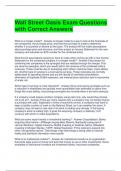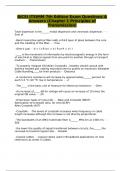Wall Street Oasis Exam Questions
with Correct Answers
What is a merger model? - Answer-A merger model is a way to look at the financials of
two companies, the purchase price, and how the purchase is made to determine
whether it is accretive or dilutive to the buyer. The analyst will first make assumptions
about purchase price and structure, and then project an Income Statement for the new
company and calculate an EPS number for the combined entity.
What kind of assumptions would you have to make when coming up with a new Income
Statement for the combined company in a merger model? - Answer-A big reason for
combining two companies is the synergies that are realized through the merger. First
are revenue synergies, which you would add to the revenue of the combined entity's
revenues. These could be due to leveraging each others' customer base, cross-selling,
etc. Another type of synergy is a cost-saving synergy. These synergies are normally
added back to operating income and are the results of overhead consolidation,
elimination of duplicate SG&A expenses, raw material price reduction due to economies
of scale, etc.
Which type of synergy is most important? - Answer-Since cost-saving synergies such as
a reduction in employees are typically more quantifiable than estimates on gains from
things like cross-selling, cost savings synergies are normally taken a bit more seriously.
If a company could acquire another company using cash only, why would they choose
not to do so? - Answer-There are many reasons why a company may not simply finance
a purchase with cash. Especially in times of economic turmoil, a company may want to
keep a healthy cushion of cash on the Balance Sheet, so it can weather the storm. A
company may not want to use cash if its stock is trading very strongly. If the buying
company's stock is trading high, it gives the acquiring company a relatively "rich"
currency with which to make acquisitions.
What are some recent trends in investment banking? - Answer-Consolidation: Banks
acquiring other banks—JPMorgan buying Bear Stearns, Barclay‖s buying part of
Lehman Brothers. Capital Infusions: Buffett investing in Goldman Sachs, Mitsubishi
investing in Morgan Stanley, TARP. Global Expansion: Firms looking to expand into
other, fast growing nations. Technology: High technology is being used to execute
trades and distribute information more quickly
What is an institutional investor? - Answer-An institutional investor is an organization
that pools large sums of money and puts that money to use in other investments. Some
examples of institutional investors are investment banks, insurance companies,
,retirement funds, pension funds, hedge funds, mutual funds, and multi-family offices.
They act as specialized investors who invest on behalf of their clients
What is securitization? - Answer-Securitization is when an issuer bundles together a
group of assets and creates a new financial instrument by combining those assets and
reselling them in different tiers called tranches. One of the reasons for the recession has
been the mortgage-backed securities market, which is made up of securitized pools of
mortgages.
What is arbitrage? - Answer-Arbitrage occurs when an investor buys and sells related
assets simultaneously in order to take advantage of temporary price differences.
Because of the technology now employed in the markets, the only people who can truly
take advantage of arbitrage opportunities are traders with sophisticated software since
price inefficiencies often close in a matter of seconds.
What is EBITDA - Answer-EBITDA stands for Earnings Before Interest, Taxes,
Depreciation, and Amortization. It is a good metric for evaluating a company's
profitability. It is sometimes used as a proxy for free cash flow because it will allow you
to determine how much cash is available from operations to pay interest, capital
expenditures, etc.
EBITDA equation - Answer-EBITDA = Revenues - Expenses (excluding interest, taxes,
depreciation, and amortization)
EV/EBITDA Multiple - Answer-A very common valuation methodology is the EV/EBITDA
multiple, which estimates the Enterprise Value of a company using a multiple of its
EBITDA. An EV/EBITDA multiple is probably the most commonly used "quick and dirty"
valuation multiple used by investment banks, private equity firms, hedge funds, etc.
How could a company have positive EBITDA and still go bankrupt? - Answer-
Bankruptcy occurs when a company can't make its interest or debt payments. Since
EBITDA is Earnings BEFORE Interest, if a required interest payment exceeds a
company's EBITDA, then if they have insufficient cash on hand, they would soon default
on their debt and could eventually need bankruptcy protection.
What is Enterprise Value - Answer-Enterprise Value = Equity Value + Debt + Non-
controlling Interest + Preferred Stock - Cash
What is net debt - Answer-Net debt is a company's total debt minus the cash it has on
the balance sheet. Net debt assumes that a company pays off any debt it can with
excess cash on the balance sheet.
Why do you subtract cash from Enterprise Value? - Answer-One good reason is that
cash has already been accounted for within the market value of equity. You also
subtract cash because it can be used either to pay a dividend or to reduce debt,
effectively reducing the purchase price of the company.
,When looking at the acquisition of a company, do you look at Equity Value or Enterprise
Value? - Answer-Because the acquiring company must purchase both liabilities and
equity in order to take over the business, the buyer will need to assess the company's
Enterprise Value, which includes both the debt and the equity
Calculating Enterprise Value tip - Answer-When calculating a company's Enterprise
Value, you use the market value of the equity because that represents the true supply-
demand value of the company's equity in the open market.
Could a company have a negative book Equity Value? - Answer-Yes, a company could
have a negative book Equity Value if the owners are taking out large cash dividends or
if the company has been operating for a long time at a net loss, both of which reduce
shareholders' equity.
What is the difference between public Equity Value and book value of equity? - Answer-
Public Equity Value is the market value of a company's equity; while the book value is
just an accounting number. A company can have a negative book value of equity if it
has been taking large cash dividends, or running at a net loss; but it can never have a
negative public Equity Value, because it cannot have negative shares or a negative
stock price.
What is Valuation - Answer-The procedure of calculating the worth of an asset, security,
company, etc.
Comparable analysis using EV/EBITDA multiple - Answer-Most often an analyst will
take the average multiple from comparable companies (based on size, industry, etc)
and use that multiple with the operating metric of the company being valued o The most
commonly used multiple is Enterprise Value/EBITDA. PE can be used
Example using EV/EBITDA multiple - Answer-Example: Comparable Company A is
trading at an EV/EBITDA multiple of 6.0x, and the company you are valuing has
EBITDA of $100 million; your company‖s EV would be valued at $600 million based on
this valuation technique.
Precedent Transactions - Answer--A precedent transaction analysis is based on the
idea that a company's worth can be determined by looking at the prices paid for similar
companies in similar situations in the past
-This valuation technique results in the highest valuation due to the inclusion of a
"control premium" the buyer is willing to pay for the assumed "synergies" they hope will
occur after the purchase
However, market conditions at the time of the prior deal may be significantly different
from those prevailing at the time of the current transaction. For example, multiples paid
for a dot-com company during the bubble in the early 2000‖s would be significantly
higher than the multiples paid for a similar company today. A good analyst will take this
into account and discount the valuation accordingly.
, LBO Valuation - Answer-An LBO (leveraged buyout) is when a firm (usually a Private
Equity firm) uses a higher than normal amount of debt (known as leverage) to finance
the purchase of a company. The PE investors will purchase the company with a
percentage (anywhere from 10% to 40%) of its own equity capital, and the remainder
will be financed with debt either through bank loans, bonds or a combination of the two.
The PE firm then uses the cash flows from the acquired company to pay off the debt
over time. Many times the PE Firm uses the assets of the company being acquired as
collateral for the loan. When the PE firm is ready to sell the company, ideally the debt
has been partially or fully paid off and they can collect most of the profits from the sale
as the majority equity owners of the company.
Since a smaller equity check was needed up front due to the higher level of debt used
to purchase the company, this can result in higher returns to the original investors than
if they had paid for the company with entirely their own equity (i.e. without any debt).
Liquid Valuation - Answer-This valuation technique uses the value of the company if
they simply sold all its assets. This might happen in a Chapter 7 bankruptcy. The
company would sell off its PP&E, inventory, etc. It may be sold at a discount to the
value it is being held on the Balance Sheet because it is a forced sale
How to answer: How would you value a company - Answer-There are a number of ways
I can think of to value a company, and I'm sure you know even more. The simplest is
probably market valuation, which is just the public Equity Value of a company based on
the public markets. To get the Enterprise Value, you add the net debt on its books,
preferred stock, and any minority interest. A few other ways to value a company include
comparable company analysis, precedent transactions, discounted cash flow, leveraged
buyout valuation, and liquidation valuation.
Which of the valuation methodologies will result in the highest valuation? - Answer-
Precedent Transcation- Includes control premiums for synergies.
DCF- Tends to be optimistic
Market Comps- Does not take into account control premiums.
Market valuation- Just equity
How to value a private company - Answer-You cannot use a straight market valuation
since the company is not publicly traded.
A DCF can be complicated by the absence of an equity beta, which would make
calculating WACC difficult. In this case, you have to use the equity beta of a close comp
in your WACC calculation.
Financial info for private companies is harder to find.
Comparables can be use but you will need a 10-15% discount as a 10-15% premium is
paid for a public company's relative liquidity
What is spreading comps - Answer-"Spreading comps" is the task of collecting and
calculating relevant multiples for comparable companies.





